
Sempervivum is a genus of about 40 species of flowering plants in the family Crassulaceae, commonly known as houseleeks. Other common names include liveforever and hen and chicks, a name shared with plants of other genera as well. They are succulent perennials forming mats composed of tufted leaves in rosettes. In favourable conditions they spread rapidly via offsets, and several species are valued in cultivation as groundcover for dry, sunny locations.

Jovibarba is a small genus of three species of succulent flowering plants in the family Crassulaceae, endemic to mountainous regions in the southeastern quadrant of Europe. The genus is sometimes classified as a subgenus of Sempervivum, to which it is closely related. Jovibarba have pale-greenish-yellow or yellow actinomorphic flowers with about six petals, while Sempervivum have generally pinkish flowers with around twice as many petals, which open more widely than jovibarba flowers. The common name hen and chicks is applied to some Jovibarba species.

Pilosella officinarum, known as mouse-ear hawkweed, is a yellow-flowered species of flowering plant in the daisy family Asteraceae, native to Europe and northern Asia. It produces single, lemon-coloured inflorescences. Like most hawkweed species, it is highly variable and is a member of a species complex of several dozens of subspecies and hundreds of varieties and forms. It is an allelopathic plant.

Primula vulgaris, the common primrose, is a species of flowering plant in the family Primulaceae, native to western and southern Europe, northwest Africa, and parts of southwest Asia. The common name is primrose, or occasionally common primrose or English primrose to distinguish it from other Primula species also called primroses. None of these are closely related to the evening primroses.
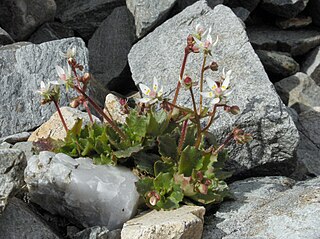
Micranthes stellaris, synonym Saxifraga stellaris, the starry saxifrage or hairy kidney-wort, is an Arctic–alpine species in the family Saxifragaceae. It produces panicles of 5–10 white flowers on a stem up to 20 cm (7.9 in) tall, rising from a basal leaf rosette. One subspecies is found from eastern Canada to Russia, including the British Isles, while another is found in the mountains of southern Europe.

Sempervivum arachnoideum, the cobweb house-leek, is a species of flowering plant in the family Crassulaceae, native to European mountains, in the Alps, Apennines and Carpathians. Growing to 8 cm (3 in) tall by 30 cm (12 in) wide, it is a rosette-forming succulent perennial, valued in cultivation for its ability to colonise hot, dry areas via offsets.

Aeonium arboreum, the tree aeonium, tree houseleek, or Irish rose, is a succulent, subtropical subshrub in the flowering plant family Crassulaceae.
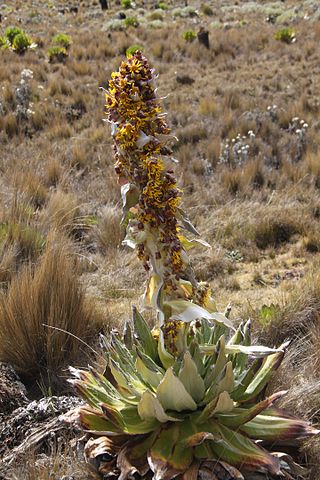
Dendrosenecio keniensis is one of the giant groundsels endemic the higher altitudes of Mount Kenya. It is in the family Asteraceae and the genus Dendrosenecio. Dendrosenecio keniodendron occurs the upper alpine zone of Mount Kenya and D. keniensis in the wetter areas of the lower alpine or the moorlands.

Dudleya abramsiisubsp.calcicola is a succulent plant known by the common name limestone liveforever, or limestone dudleya. It is endemic to California, where it is a rare resident of limestone outcroppings and rocky slopes in the southern Sierra Nevada and nearby mountains and foothills. It was formerly regarded as Dudleya calcicola.

Dudleya stolonifera is a succulent plant known by the common name Laguna Beach liveforever or Laguna Beach dudleya. This is a rare plant which is endemic to the coastline of Orange County, California. It is known from only about six populations in the vicinity of Laguna Beach, totaling about 30,000 individuals. It is federally listed as a threatened species of the United States.
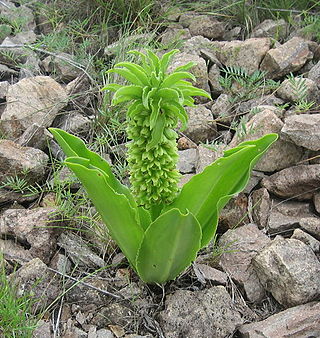
Eucomis autumnalis, the autumn pineapple flower, or autumn pineapple lily, is a species of flowering plant in the family Asparagaceae, subfamily Scilloideae, native to Malawi, Zimbabwe and southern Africa. It is a mid to late summer flowering deciduous bulbous perennial. The flower stem reaches about 40 cm (16 in), rising from a basal rosette of wavy-edged leaves. The green, yellow or white flowers are arranged in a spike (raceme), topped by a "head" of green leaflike bracts. It is grown as an ornamental garden plant and can also be used as a cut flower.

Dudleya attenuata is a species of perennial succulent plant known by the common name taper-tip liveforever, native to Baja California and a small portion of California. A rosette-forming leaf succulent, it has narrow pencil shaped leaves that can often be found covered in a white epicuticular wax. The thin, sprawling stems branch to form the clusters of rosettes, with plants creating a "clump" up to 40 cm wide. The small flowers are white or yellow, with 5 spreading petals. It is a diverse, variable species that extends from the southernmost coast of San Diego County to an area slightly north of the Vizcaino Desert, hybridizing with many other species of Dudleya in its range. Some plants with white or pinkish flowers were referred to as Orcutt's liveforever, referring to a former subspecies split on the basis of the flower color.
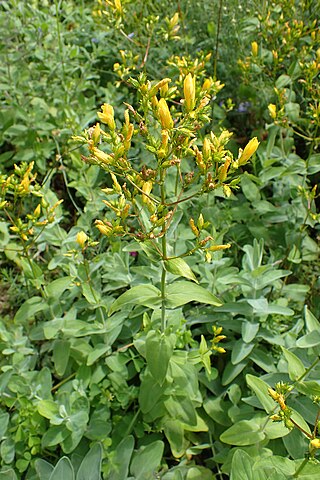
Hypericum annulatum is a species of flowering plant in the family Hypericaceae. It is a perennial herb of varying heights which grows upright, with more than a hundred flowers of a golden yellow color. First described in 1827, the species has a wide distribution from Eastern Europe to East Africa, and its appearance can vary greatly based on its geographic location. It has been used in Bulgarian folk medicine, and has more recently been investigated for its effectiveness in slowing the growth of or killing certain types of human cancer.

Felicia fruticosa is a strongly branching shrub of up to 1.3 metres high that is assigned to the family Asteraceae with flower heads consisting of about twenty purple to white ray florets encircling many yellow disc florets, and small flat, entire and hairless leathery leaves. Two subspecies are recognized. Felicia fruticosa subsp. brevipedunculata, from the Limpopo Province of South Africa is up to 1.3 metres tall and has longer leaves of 2.5 centimetres (0.98 in) long and 2 millimetres (0.079 in) wide and nearly seated pale violet to white flower heads. Felicia fruticosa subsp. fruticosa, from the Western Cape province of South Africa, is no more than 1 m and has shorter leaves of 1.25 centimetres (0.49 in) long and 2.5 millimetres (0.098 in) wide with flower heads on largely leafless, about 2.5 centimetres (0.98 in) long stems. It is sometimes called bosastertjie in Afrikaans. In the wild, flower occurs from August till October.
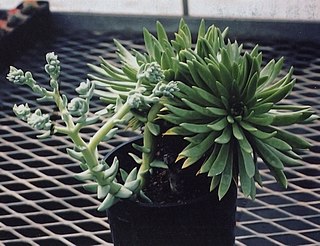
Dudleya guadalupensis is a very rare species of succulent perennial plant in the family Crassulaceae commonly known as the Guadalupe liveforever. It is a rosette-forming leaf succulent, with foliage that is variously colored light green, green, and a waxy white. It is characterized by dense leaves that fold over the center in dormancy, a curving, sinuous flower stalk, and white, cup-shaped flowers. It is endemic to the rocks and islets off of Guadalupe Island, an isolated volcanic island in the Pacific Ocean located 241 kilometers off of the coast of Baja California.

Dudleya saxosa subsp. collomiae, known by the common name Gila County liveforever, is a subspecies of perennial succulent plant within the genus Dudleya native to central Arizona. It is characterized by showy bright-yellow flowers on an upright inflorescence colored pink, red or orange. The leaves are green or covered in a white, powdery wax. This species is found growing in rocky slopes, canyons, and crevices, and often on Sonoran Desert sky islands.
Dudleya cymosasubsp. costatifolia, known commonly as the Pierpoint Springs dudleya or the Pierpoint Springs liveforever, is a species of succulent plant in the family Crassulaceae, narrowly endemic to a locality in Tulare County, California, United States. It is a clumping plant with small rosettes and bright yellow flowers, resembling alpine cushion plants.
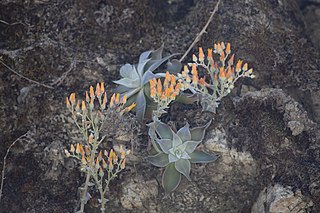
Dudleya cymosasubsp. pumila, most commonly known as the low canyon dudleya, chalky canyon dudleya or California live-forever, is a species of perennial succulent plant. It has diamond to spoon shaped leaves, sometimes coated with a fine white powder, and in May through July, bright red, orange or yellow flowers adorn the short inflorescence. A leaf succulent primarily found growing in rocky cliffs and slopes, it is endemic to California, and grows in the Transverse Ranges and South Coast Ranges, with some outlying populations. A variable plant, in some localities it is difficult to distinguish from other plants in the genus.
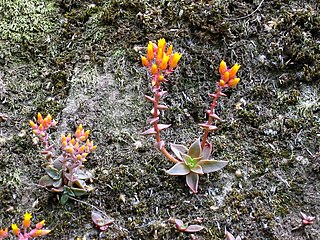
Dudleya cymosa subsp. marcescens is a species of summer-deciduous succulent plant known commonly as the marcescent dudleya or marcescent liveforever. Throughout the months of spring, it is characterized by a bloom of small, bright-yellow flowers with 5 petals, tinged with orange or red. It is a leaf succulent with a basal rosette, with the foliage withering in summer, going completely leafless, a neotenous trait in the genus. This species is endemic to the exposed volcanic rock of the Santa Monica Mountains in California, being found on shady slopes and outcroppings. It differs from its local congeners with its deciduous habit, slender caudex, and narrower leaf shape, although it is superseded in some of these characteristics by Dudleya parva, growing 13 km to the north, which has even narrower leaves and is quicker to lose them. Because of its restricted distribution and small size, it is vulnerable to habitat degradation and disturbance from acts of graffiti and rock climbers. It is listed as threatened by the United States Fish and Wildlife Service.

Dudleya cymosasubsp. agourensis, commonly known as the Agoura Hills dudleya or Agoura Hills liveforever, is a species of perennial succulent plant. A rare and critically imperiled species from the Santa Monica Mountains in California, it is characterized by glaucous, gray-purple leaves, bright yellow flowers, and ascending bracts. A leaf succulent, it is found growing on west to northwest-facing open, rocky volcanic slopes.




















